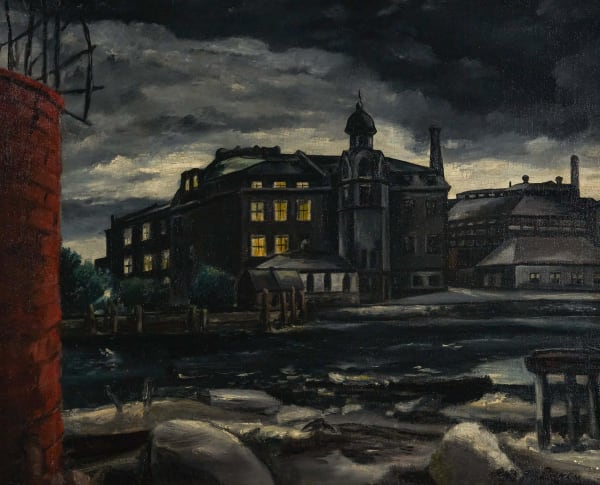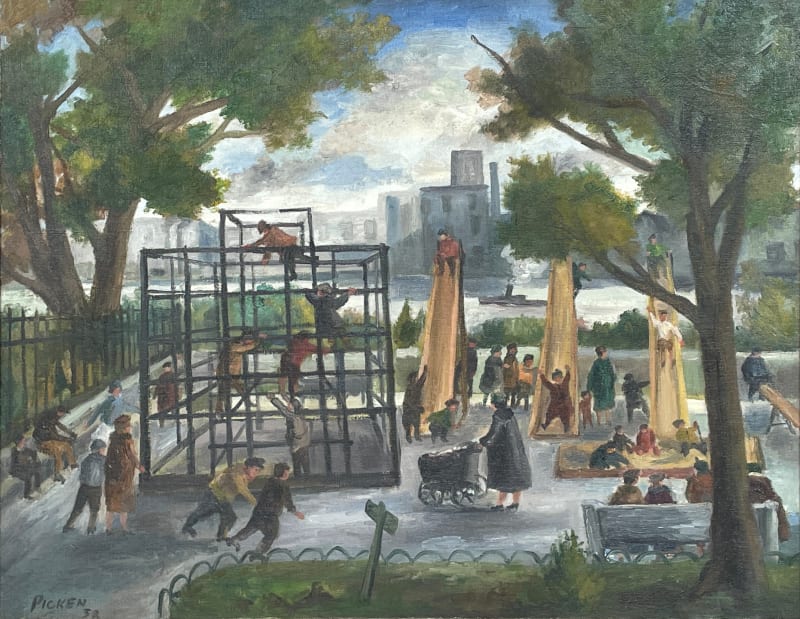A native New Yorker, George Picken was born in 1898. His father, an artist and photographer, emigrated from Scotland; his mother came from Wales. They joined other European immigrants settling in New York City’s Hell’s Kitchen. Picken enlisted in the army during World War I and saw action at Verdun. After the war, he stayed in France and like many Americans returning from the vibrant Paris art scene, was inspired by the radical movement known as Impressionism. Upon his return Picken decided to follow in his father’s footsteps and become an artist.
George began his studies in 1919 at the Art Students League during Robert Henri, Max Weber, and John Sloan’s tenure. There he took classes in studio art, illustration, and etching through 1923 studying extensively with George Bridgman. The writings of French philosopher Henri Bergson were widely circulated among the artistic community and looking at Picken’s early paintings one cannot help but wonder if as a young artist he was influenced by Bergson’s ideas. Bergson said, "[There are] two profoundly different ways of knowing a thing. The first implies that we move round the object; the second that we enter into it. The first depends on the point of view at which we are placed and on the symbols by which we express ourselves. The second neither depends on a point of view nor relies on any symbol. The first kind of knowledge may be said to stop at the relative; the second, in those cases where it is possible, to attain the absolute.”
Picken’s recognition came early with showings of his work while he was a student. His drawings were published in the New Masses, a significant left-wing publication. The New York Public Library honored him with one-man shows in 1924 and 1928 and his work was included in group exhibitions at the Louis Comfort Tiffany Foundation, the Whitney Studio Club, Montross Gallery, and the Art Students League. During this time Picken married Viola Carton, one of Reginald Marsh’s models, and they lived in Westchester. Later they moved to Yorkville in Manhattan between 82nd street and East End Avenue where they began their family. Picken’s grandson Niles Jaeger recalled that, “Grandpa’s home and studio were in a five-story walk-up apartment, heated only by a coal stove. But there were wonderful views of the East River and the Queensborough Bridge and he painted them repeatedly over the next three decades.”
Picken felt the financial panic and economic depression that engulfed most of the world in 1931; [he] was trying to support a wife and two children on his earnings as an artist….Franklin Delano Roosevelt promised “a new deal for the American people” at the 1932 Democratic Convention [and] the Federal Art Project was formed. During the run of the [WPA] over ten thousand artists were employed including Picken’s friends Stuart Davis and Reginald Marsh. Arshile Gorky, Isabel Bishop, Grant Wood, Ben Shahn, Adolph Gottlieb, David Smith, Willem deKooning, Jackson Pollock, Mark Rothko, Ad Reinhardt, and Paul Cadmus also found work. Along with Rockwell Kent, John Steuart Curry, and Thomas Hart Benton, Picken was commissioned to do public murals. Picken’s work can be found in the Post Offices of Hudson Falls and Fort Edward, New York and Chardon, Ohio. He also completed public murals for St. Ambrose Church in Brooklyn and Hawthorne Public School in Hawthorne, New York.
In 1933 George Picken was also offered a position as a teacher at the Art Students League. He taught printmaking there through 1942 as well as teaching painting, printmaking, and lithography at Cooper Union and holding a position at Columbia University. During this time Picken achieved notoriety for his paintings of industrial and city scenes like Mining Town. Stuart Davis remarked that his friend’s dark urban scenes were like “dungeons.” Marie Harriman, wife of railroad baron Averill Harriman, was Picken’s first patron giving him one-person shows at her gallery. In the 1940s with the guidance of Edward Hopper, Picken joined the prestigious Rehn Galleries on Madison Avenue. Rehn Galleries also exhibited the work of Reginald Marsh and Charles Burchfield. Picken’s had regular one-person shows there until his death.
George Picked retired to Tyringham and continued painting and gardening until his death at the age of seventy-three in 1971. Picken’s work is in many private and public collections including the Whitney Museum of American Art, The Corcoran Gallery of Art, The Metropolitan Museum of Art, Dartmouth College, the Kansas City Art Institute, the Smithsonian Institution, the Library of Congress, the Parrish Art Museum, Syracuse University, the Art Students League, and the Newark Museum.




